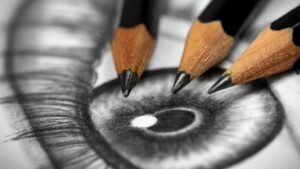Pencil drawings hold a timeless charm that captivates both artists and admirers. This art form, known for its simplicity and versatility, allows for the expression of intricate details and subtle textures. Pencil drawings can range from delicate sketches to highly detailed portraits, showcasing the artist’s skill and creativity.
The beauty of pencil drawings lies in their accessibility. With just a pencil and paper, artists can explore a world of possibilities, making it an ideal medium for beginners and professionals alike. The monochromatic palette encourages a focus on form and shading, pushing artists to hone their techniques.
As digital art rises in popularity, pencil:f9kdhkibbmm= drawings maintain their unique appeal by offering a tactile experience that digital mediums can’t replicate. They serve as a testament to the enduring power of traditional art forms, continually inspiring new generations to pick up a pencil and create.
Pencil:f9kdhkibbmm= Drawings

Pencil drawings have a rich history that traces back to the 16th century with the discovery of a massive graphite deposit in Borrowdale, England. Artists quickly embraced graphite for its ability to produce lines with varying intensity, adding depth to pencil drawings. By the 17th century, the development of wooden holders for graphite led to the modern pencil, enhancing the artistry of pencil drawings, much like how the rise of yoga in recent times has improved emotional well-being by promoting mindfulness and balance.
In the 18th and 19th centuries, pencil drawings gained popularity among European artists like Jean-Auguste-Dominique Ingres, who appreciated the medium’s precision for creating detailed sketches. The industrial revolution further improved pencil production, making pencil drawings more accessible.
By the 20th century, renowned artists such as Pablo Picasso explored pencil drawings, experimenting with abstract and surreal concepts. Today, pencil drawings remain a fundamental skill in art education and continue to inspire artists worldwide, reflecting centuries of artistic evolution and innovation.
Techniques For Pencil:f9kdhkibbmm= Drawings

Effective techniques elevate pencil drawings by highlighting depth and detail. Artists use shading to create dimension, employing techniques like hatching, cross-hatching, and stippling. Hatching involves drawing parallel lines, while cross-hatching layers lines at angles for texture in pencil drawings. Stippling uses dots to build form and shadow.
Blending is another essential method. Smudging tools, like tortillons or fingers, soften lines and transitions. This technique in pencil drawings achieves smooth gradients and realistic textures.
Sharp lines add contrast. Artists employ varying pencil grades, using hard pencils (e.g., H or HB) for precise lines and softer pencils (e.g., 2B to 6B) for bold, dark strokes. Also, erasers become tools for lightening areas, enhancing highlights in pencil drawings.
Layering involves starting with light sketches and gradually adding darker tones. This method refines shapes and brings complexity to pencil drawings, ensuring a dynamic range of values.
Tools For Pencil:f9kdhkibbmm= Drawings

Quality tools enhance the experience of creating pencil drawings. Artists need a variety of pencils with different graphite grades to achieve diverse textures. A hard pencil, such as a 4H, results in lighter tones, while a soft pencil, like 6B, produces darker shades. Erasers, such as a kneaded one, are indispensable for lifting graphite without damaging the paper. High-quality drawing paper offers a smooth or textured surface, allowing for detailed work in pencil drawings.
Additional tools include blending stumps and tortillons, which help in achieving smooth transitions between different shades. A sharpener ensures pencils remain precise, enabling artists to create intricate details in their pencil drawings. Artists also utilize fixatives to preserve their work and prevent smudging. Finally, rulers and compasses aid in executing geometric patterns, expanding the potential of pencil drawings. With the right tools, beginners and professionals can explore the limitless possibilities of this versatile medium.
Famous Pencil:f9kdhkibbmm= Drawings And Artists
Pencil drawings have left a significant mark on the art world, with many renowned artists using this medium to create iconic works. The delicate precision of Jean-Auguste-Dominique Ingres’ sketches showcases the medium’s potential for capturing fine details. Pablo Picasso’s exploration of abstract forms in pencil highlights its versatility in conveying complex ideas. These artists, among others, have demonstrated the enduring power of pencil drawings, inspiring countless creators to explore and push the boundaries of this timeless art form. As artists continue to innovate, pencil drawings remain a cornerstone of artistic expression, bridging centuries of tradition with modern creativity.

